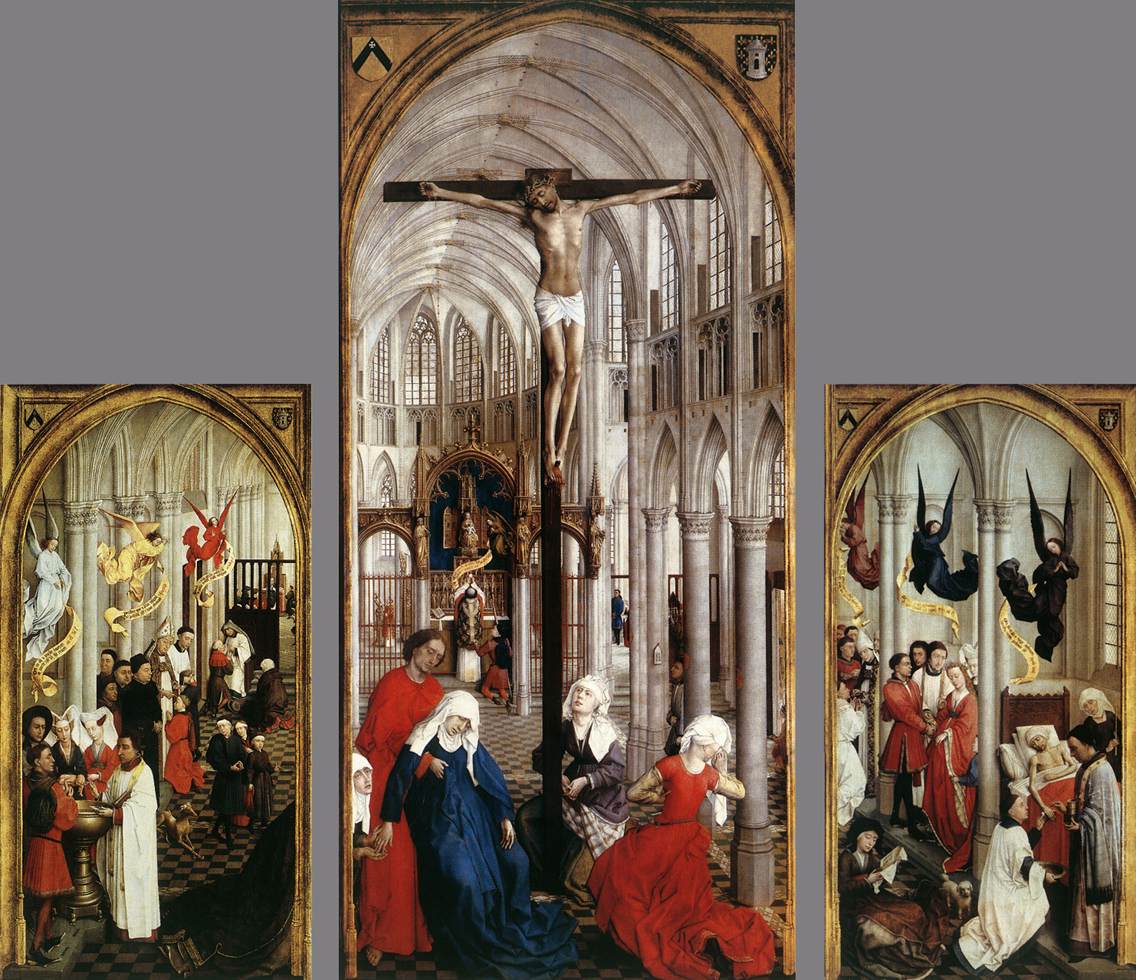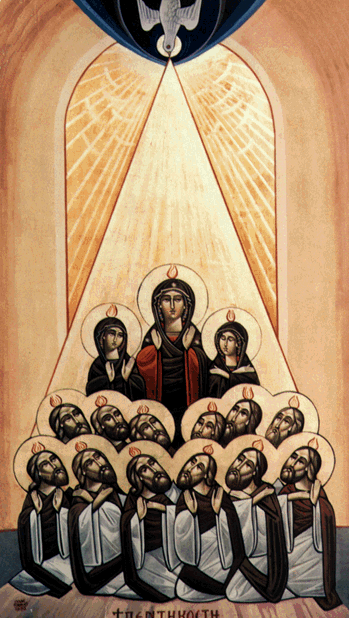 | Theophanos of Crete, Icon of Christ, Stavronikita Monastery (Mt. Athos)
This icon is printed right at the beginning of the Compendium, between the Motu Proprio and the Introduction. From the description: "This image, a sublime synthesis of natural and symbolic elements, is an invitation to contemplate ad to follow the Lord. Jesus through the Church, his bride and mystical body, still continues today to bless the human family and to shed light upon it with his Gospel which is the authentic book of truth, happiness, and salvation for man. In August of 386 while in a garden, Augustine heard a voice saying "Take and read, take and read" (Confessions, 8,12,29). The Compendium of the Catechism of the Catholic Church, as a synthesis of the Gospel of Jesus taught by the Church's catechesis is an invitation to open the book of truth and to read it, even to devour it as did the prophet Ezekiel (cf. Ezekiel 3:1-4)." |
Each work is accompanied by a description detailing its artistic and theological symbolism, which I have excerpted here.  | Gentile da Fabriano, Adoration of the Magi (1423)
Occurs immediately before Part One: The Profession of Faith "The Gospel of Jesus is the word of salvation for all humanity. Saint Leo the Great said, "Let all peoples, represented by the three magi, adore the Creator of the universe and may God be know not just in Judea but through all the earth because everywhere in Israel great is his name. (Discourse 3 for the Epiphany) The first part of the Compendium illustrates the encounter between God and man and the response of faith which the Church gives in the name of all people to the gift of the redeeming incarnation of the Son of God and his divine revelation." |
 | Bible of Souvigny, Days of Creation
Occurs at the beginning of Section One: "I Believe" -- "We Believe" "The church at Easter vigil praises the Lord for the even more wonderful work of the redemption of mankind and the cosmos: 'Almighty and eternal God, you created all things in wonderful beauty and order. Help us now to perceive how still more wonderful is the new creation by which in the fullness of time you redeemed your people through the sacrifice of our Passover, Jesus Christ.'" |
One complaint I will make is that the reprints use extremely bright colors. Perhaps this was done to bring out the detail on the non-glossy paper, but it looks a bit off, even garish in some of the works. Still, I'm thrilled that the decision was made to include the art, and they made some excellent choices to highlight in pictures the truths that follow in words.  | Basilica of San Clemente, Apse Mosaic
Occurs at the beginning of Section Two: The Profession of Faith "The Church is here pictured as a heavenly garden given life by Christ, the true tree of life." |
 | Joos van Wassenhove, Jesus Gives Communion to the Apostles
Printed at the beginning of Part Two: The Celebration of the Christian Mystery "Aquinas, who called the Eucharist "the summit and perfection of all the spiritual life," could not but express the consciousness of the Church's faith for she believes in the Eucharist as the living presence of Jesus among us and as the indispensable nourishment for the spiritual life. The Eucharist is the golden thread that, beginning with the Last Supper, binds together all the ages of the Church's history up to ourselves today." |
 | Redemptoris Mater chapel, Mosaic on the wall of the Incarnation
Printed at the beginning of Part Two, Section One: The Sacramental Economy "The sacrifice of the cross is the found of the sacramental economy of the Church. In this image Mary, who is a figure for the Church, gather in her left hand the blood and water which flow from the open side of Christ and which are symbols of the Church's sacraments." |
 | Roger van der Weyden, Triptych of the Seven Sacraments
Printed at the beginning of Part Two, Section Two: The Sacraments of the Church "At the center the cross is raised in a predominant way. At the feet of the Crucified, there is Mary, heartbroken, supported by John and the holy women. In the back a priest celebrating Mass elevates the Host after the consecration to show that the sacrifice of the cross is made present again in the Eucharistic celebration under the forms of bread and wine." |
 | Jacob Copista, Illustration from the Tetraevangelo
Found at the beginning of Part Three: Life in Christ "In this image, Jesus is seated with the apostles around a table in the form of a chalice. On the table are the Eucharistic species: bread and wine. The hall which is displayed against a very elaborate architectural backdrop with the buildings and a circular tabernacle with seven columns symbolizes the Church which is the abode of the Eucharistic Christ. A significant detail is offered by the apostle John which rests his head upon Jesus' chest (cf. John 13:25). He displays the communion of love which the Eucharist produces in the faithful." |
 | El Greco, St. John Contemplates the Immaculate Conception
Found at the beginning of Part Three, Section One: Man's Vocation: Life in the Spirit "In this image Mary is surrounded by angels playing musical instruments and making merry, her head crowned with the divine love of the Holy Spirit, symbolized by the dove. Mary is the mother and protector of the Church (at her feet there is a faint glimpse of a sacred edifice). Through her efficacious, motherly intercession with Jesus, she pours out upon the Church the abundance of heavenly graces (symbolized by the tuft of blooming roses). Below at the left, the apostle John in contemplation of Immaculate Mary represents every on eof the faithful who sees in the Blessed Virgin the perfect modeland likewise the teacher and guide for living in the Spirit." |
 | Fra Angelico, Sermon on the Mount
Part Three, Section Two: The Ten Commandments "The mountain with its elevation above the earth and closeness to heaven describes a privileged place of encounter with God. Jesus the teacher, seated on the rock as on a favored chair with the index finger of his right hand pointed to heaven, indicates the divine origin of his words of life and happiness. The scroll which he holds in his left hand signifies the ful fillment of his teaching which he entrusts with confidence to the apostles who are invited to preach the Gospel to all nations, baptizing them in the name of the Father, Son, and Holy Spirit." |
 | Coptic Icon of Pentecost
Part Four: Christian Prayer Mary, mother of the Church, the Queen of the apostles, and the perfect pray-er, is the dominant figure at the center of the icon. It is in the love of the Holy Spirit that the faithful can raise their filial prayer to God in accord with the words of the apostle: 'As proof that you are children, God sent the spirit of his Son into our hearts, crying out, "Abba, Father!"' (Galatians 4:6)." |
 | Byzantine Icon of the Liturgical Feasts (This is actually a Russian icon on the same subject; I couldn't find a picture of the one that is in the book.)
Part Four, Section One: Prayer in the Christian Life "All times are good for prayer. The Church, however, proposes special times to the faithful to stress and nurture continual prayer: morning and evening prayer, prayers before and after meals, the liturgy of the hours, the Sunday Eucharist, the rosary, and the feasts of the liturgical year. This icon portrays some of the major feasts of the liturgical year which mark the prayer of the Church. The representation of the paschal mystery, the resurrection and the ascension of Jesus into heaven, is the dominant figure at the center of the icon. This solemn feast is the summit of liturgical prayer and from it all the other feasts, both those of Jesus and Mary, draw their meaning and saving efficacy." |
 | El Greco, Agony in the Garden
Part Four, Section Two: The Lord's Prayer "The disciples, who had experience with Jewish prayer at the time, were greatly struck by the singular character of the prayer of their Master. Jesus actually was in continual prayer. The most important moments of his life were accompanied by prayer. ... Prayer to the Father was the life breath of his earthly existence. He came to dwell in our midst but Jesus did not leave the house of the Father because he kept communion with him in prayer. On the other hand, however, this filial intimacy became a merciful and saving closeness for his brothers right up to the supreme sacrifice of the cross." |
 | Jan van Eyck, Angelic Singers, (Ghent Cathedral)
Appendices: A. Common Prayer, and B. Formulas of Catholic Doctrine. "The image presented here portrays a group of apterous angels (without wings) who pray by singing. They are dressed in sumptuous sacred vestments to indicate that they are discharging a solemn liturgical action. Indeed the angels, besides being messengers of God who are sent to declare his sovereign will to men, perform also the service of praising the Lord in the eternal liturgy of heaven (cf. Revelation 8:2)." |












